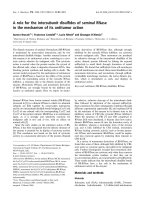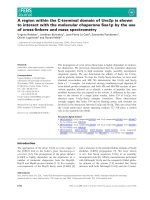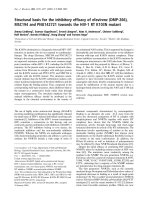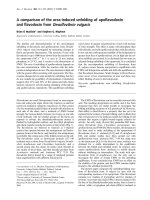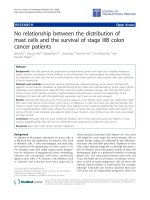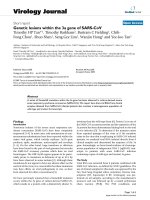Báo cáo sinh học: "A comparison between the β-globin gene clusters of domestic sheep (Ovis aries) and Sardinian mouflon" docx
Bạn đang xem bản rút gọn của tài liệu. Xem và tải ngay bản đầy đủ của tài liệu tại đây (366.71 KB, 6 trang )
Original
article
A
comparison
between
the
β-globin
gene
clusters
of
domestic
sheep
(Ovis
aries)
and
Sardinian
mouflon
(Ovis
gmelini
musimon)
A
Rando
1
P
Di
Gregorio
2
M
Capuano
C
Senese
L
Manca’
S
Naitana
3
B
Masala
2
1
Dipartimento
di
Scienze
delle
Produzioni
Animali,
i7n!uerst<a
degli
Studí
della
Basilicata,
Via
N
Sauro
85,
85100
Potenza;
2
Istituto
di
Fisíologia
Generale
e
Chimica
Biologica,
!7n!t)erst<a
deg
li
Studi
di
Sassari,
Via
Muroni
25;
3
Istituto
dí
Fisiologia
degli
Animali
Domestici,
!7
Ktoerstta
degli
Studi
di
Sassari,
Via
Vienna
2,
07100
Sassari,
Italy
(Received
15
March
1995;
accepted
15
February
1996)
Summary -
The
organization
of
the
,0-globin
gene
cluster
of
wild
Sardinian
mouflons
with
different
haemoglobin
phenotypes
has
been
analyzed
by
means
of
Southern
blot
with
probes
specific
for
e
IV
and
(3F-
globin
genes.
With
three
endonucleases
(Bam
HI,
Eco
RI,
and
Hind
III),
Sardinian
mouflons with
Hb
B,
Hb
BM
and
Hb
M
show
identical
restriction
patterns
to
sheep
with
Hb
A,
Hb
AB,
and
Hb
B,
respectively.
Therefore,
in
Sardinian
mouflons
as
in
domestic
sheep,
the
#-globin
gene
cluster
shows
two
haplotypes
characterized
by
the
triplication
or
duplication
of
an
ancestral
four
gene
set
(£-£-1
jJ(3-(3).
domestic
sheep
/
Sardinian
mouflon
/
haemoglobin
/
j3-globin
cluster
Résumé -
Comparaison
du
groupe
de
gènes
de
la
globine-,8
du
mouton
domestique
(Ovis
aries)
et
du
mouflon
de
Sardaigne
(Ovis
gmelini
musimon).
L’organisation
du
groupe
de
gènes
de
la
globine-(3
chez
des
mouflons
de
Sardaigne
montrant
divers
phénotypes
d’hémoglobine
a
été
analysée
par
buvardage
de
Southern
avec
des
sondes
spécifiques
pour
les
gènes
e
IV
et
j3
F.
Avec
trois
endonucléases
(Bam
HI,
Eco
RI
et
Hind
III),
les
mouflons
caractérisés
par
les
phénotypes
d’hémoglobine
B,
BM
et
M
montrent
des
patrons
de
restriction
identiques
aux
moutons
ayant
les
phénotypes
d’hémoglobine
A,
AB
et
B
respectivement.
Par
conséquent,
le
groupe
de
gènes
de
la
globine-(3
manifeste
dans
ces
deux
espèces
deux
haplotypes
caractérisés
par
la
duplication
ou
le
triplement
d’un
ensemble
de
quatre
gènes
ancéstravx :
£ - £ - wj3 - 13.
mouton
/
mouflon
de
Sardaigne
/
hémoglobine
/
globine-(3
INTRODUCTION
The
domestic
sheep
(Ovis
aries)
#-globin
gene
cluster
shows
two
common
haplo-
types:
the
A
haplotype
bearing
the
adult
HBB
A
allele
and
the
B
haplotype
bearing
the
adult
HBB
B
allele
(Garner
and
Lingrel,
1988,
1989).
The
A
haplotype
is
similar
to
the
goat
(Capra
hircus)
#-globin
gene
cluster
(Townes
et
al,
1984)
and
shows
the
triplication
(5! - e&dquo; - ! - /?c _ !111 _ !iv _ !ti _ !A _ !v _ !vi _ !m _ !Fg.) !
an
ancestral
four
gene
set
(E - E - ’IjJ,8 -,8)
characterized
by
two
embryonic
genes
(E
),
one
pseudogene
(’IjJ,8),
and
one
gene
(0)
whose
expression
varies
as
a
function
of
on-
togenic
development
and
physiological
conditions.
In
fact,
13C,,3 A ,
and
0F
genes
are
expressed
during
juvenile,
adult,
and
fetal
life,
respectively
(Huisman
et
al,
1969).
The
,8c
and
(!A
switch
is
reversible
under
particular
physiological
or
experimental
conditions
(anaemia,
hypoxia
or
under
administration
of
erythropoietin)
(Huisman
et
al,
1967;
Boyer
et
al,
1968).
The
B
haplotype,
lacking
the
whole
juvenile
four-
gene
set,
is
duplicated
(5’EI -
E
II -
’IjJ,81 _,8B -
E
III
-
E
IV -
’IjJ,81
I
-
!F3!),
Therefore,
sheep
homozygous
for
the
HBB
B
allele
do
not
exhibit
the
property
of
,8
B
>
,8
c
switching
as
they
do
not
possess
the
,8
c
gene.
Since
domestic
sheep
,8
A
and
!3B
allelic
chains
differ
by
at
least
seven
scattered
amino-acid
residues
and
no
interme-
diate
haplotype
has
been
found,
it
has
been
proposed
that
this
polymorphism
is
the
product
of
genetic
isolation
followed
by
admixture
(Boyer
et
al,
1966).
Manwell
and
Baker
(1976)
suggest
that
man
has
played
a
role
in
generating
haemoglobin
polymorphisms
in
domesticating
sheep
by
hybridizing
individuals
that
would
other-
wise
be
geographically
isolated.
Southern
blot
analysis,
using
/3-like
globin
genes
as
probes
and
several
endonucleases,
strongly
supports
the
polyphyletic
origin
of
the
domestic
sheep.
In
fact,
by
means
of
this
technique,
A
and
B
haplotypes
can
be
easily
distinguished
since
they
differ
in
both
number
and
length
of
restriction
fragments
and
show
no
intermediates
(Di
Gregorio
et
al,
1987;
Rando
et
al,
1989).
Some
authors
(Bunch
et
al,
1976;
Bunch
and
Nadler,
1980;
Bunch
and
Nguyen,
1982;
Ryder,
1984;
Di
Gregorio
et
al,
1987)
consider
the
mouflon
as
one
of
the
ancestors
of
the
present
day
domestic
sheep,
whereas
others
(Poplin,
1979;
Vigne,
1983)
claim
that
it
originated
by
feralization
of
the
first
domesticated
sheep
in
the
Corsico-Sardinian
islands
(Neolithic).
In
wild
mouflons
(Ovis
gmelini
rnusimon)
captured
in
Sardinia,
two
alleles
at
the
adult
/3-globin
locus
have
been
observed:
HBB
B
and
HBB’u,
with
frequencies
of
0.94
and
0.06
respectively.
Both
adult
#-globin
variants
in
this
species
are
electrophoretically
different
from
those
observed
in
sheep
(Naitana
et
al,
1990).
No
homozygous
individuals
for
the
HBB‘
u
allele
had
been
found
(Naitana
et
al,
1990).
In
this
paper,
with
the
availability
of
a
mouflon
homozygous
for
the
!fBB!
allele,
we
compared
the
organization
of
the
#-globin
clusters
of
wild
Sardinian
mouflons
and
domestic
sheep
with
different
Hb
phenotypes
by
means
of
Southern
blot
analysis.
MATERIALS
AND
METHODS
Haemoglobin
phenotypes
of
sheep
and
wild
Sardinian
mouflons
were
determined
by
means
of
isoelectric
focusing
in
the
pH
range
6.7-7.7
and
by
gel
electrophoresis
of
dissociated
globin
chains
(Naitana
et
al,
1990;
Masala
et
al,
1991).
Southern
blot
analysis
was
accomplished
on
DNA
samples
obtained
from
six
mouflons
selected
according
to
Hb
phenotype
(3
Hb
B,
2
Hb
BM,
and
1
Hb
M)
and,
as
a
comparison,
from
six
sheep
(2
Hb
A,
2
Hb
AB,
and
2
Hb
B).
DNA
samples
were
digested
with
Hind
III,
Ba!n
HI,
and
Eco
RI
and
probed
with
plasmid
pG16Ec3Bm2
(containing
the
5’
of
the
goat
EI
V -globin
gene)
and
plasmid
pGq5’
(containing
the
5’
of
the
goat
!3F-globin
gene).
According
to
the
hybridization
conditions
reported
by
Rando
et
al
(1989),
these
plasmids
(a
kind
gift
from
JB
Lingrel)
strongly
cross-hybridize
with
the
paralogous
genes.
RESULTS
AND
DISCUSSION
Southern
blot
analysis
of
mouflon
and
domestic
sheep
genomic
DNAs
digested
with
Hind
III,
Barra
HI,
and
Eco
RI
and
hybridized
with
e
iv
and
,8
F
probes
demonstrates
that
mouflons
with
Hb
B,
Hb
BM,
and
Hb
M
show
the
same
electrophoretic
pat-
terns
as
domestic
sheep
with
Hb
A,
Hb
AB,
and
Hb
B,
respectively.
As
an
example,
figure
1
shows
digestion
of
mouflon
and
domestic
sheep
genomic
DNA
with
Bam
HI
and
hybridization
with
the
e
IV
gene.
It
can
be
seen
that
restriction
patterns
of
mouflons
with
Hb
B
and
domestic
sheep
with
Hb
A
(homozygotes
for
the
tripli-
cated
haplotype)
are
characterized
by
fragments
of
9.0,
5.5,
and
6.6
kb
containing
the
E
pair
genes
of
the
juvenile,
adult,
and
fetal
sets,
respectively
(Rando
et
al,
1989).
On
the
other
hand,
restriction
patterns
of
mouflons
with
Hb
M
and
domes-
tic
sheep
with
Hb B
(homozygotes
for
the
duplicated
haplotype)
are
characterized
by
fragments
of
5.7
and
6.6
kb
that
previous
reports
show
contain
the
e
pair
genes
of
the
adult
and
fetal
sets,
respectively
(Garner
and
Lingrel,
1988;
Rando
et
al,
1989).
Figure
2
summarizes
results
obtained
with
the
three
endonucleases
and
the
two
probes.
Thus
the
Sardinian
mouflon
shows
two
haplotypes
at
the
#-globin
gene
cluster,
a
triplicated
one
bearing
the
adult
HBB
B
allele
corresponding
to
the
sheep.
A
haplotype,
and
a
duplicated
one
bearing
the
adult
HBB
M
allele
corresponding
to
the
sheep
B
haplotype.
According
to
the
results
presented
in
this
paper,
the
two
haplotypes
differ
not
only
by
the
presence/absence
of
the
juvenile
set
but
also
by
many
other
mutations
evidenced
by
different
restriction
endonucleases
(see
fig
2).
The
absence
of intermediate
haplotypes
in
both
sheep
(Di
Gregorio
et
al,
1987;
Rando
et
al,
1989)
and
mouflon
confirms
the
hypothesis
that
the
two
haplotypes
evolved
separately
(Boyer
et
al,
1966)
and,
at
the
same
time,
demonstrates
that
they
were
present
in
ancestor
common
to
both
species.
According
to
data
presented
by
Naitana
et
al
(1990),
the
frequency
of
the
HBB
B
allele
(triplicated
switching
cluster)
is
much
higher
in
Sardinian
mouflons
(0.94)
than
in
domestic
sheep
and, in
particular, in
the
Sarda
breed
sheep
which
is
almost
monomorphic
for
the
HBB
B
allele
(duplicated
non-switching
cluster)
(Manca
et
al,
1993)
and
lives
in
the
same
environment.
Therefore,
it
remains
to
be
established
whether
the
marked
differences
in
the
frequencies
of
’switching’
and
’non-switching’
chromosomes
between
Sardinian
mouflon
and
sheep
are
the
result
of
genetic
drift,
natural
selection
or
domestication.
Masala
et
al
(1991)
put
forward
the
possibility
of
an
advantage
in
synthesizing
Hb
C
in
a
wild-type
niche
in
the
case
of
mouflon.
Evans
and
Turner
(1965)
evidenced
a
certain
reproductive
advantage
of
the
duplicated
cluster
in
sheep.
If
we
consider
that
the
domestic
sheep
has
been
the
object
of
selective
pressure
for
milk,
wool,
and
meat
production,
it
could
be
that
man,
through
domestication
and
artificial
selection,
is
responsible
for
the
high
frequency
of
the
duplicated
cluster
in
domestic
sheep.
ACKNOWLEDGMENT
This
research
was
supported
by
the
National
Research
Council
of
Italy,
Special
Project
Raisa,
Sub-project
No
3;
Paper
No
13
2578.
REFERENCES
Boyer SH,
Hathaway
P,
Pascasio
F,
Orton
C,
Bardley
J,
Naughton
MA
(1966)
Hemo-
globins
in
sheep:
multiple
differences
in
amino
acid
sequences
of
three
#-chains
and
possible
origins.
Science
153,
1539-1543
Boyer
SH,
Crosby
EF,
Noyes
AN,
Kaneko
JJ,
Keeton
K,
Zinkl
J
(1968)
Hemoglobin
switching
in
non-anemic
sheep.
Johns
Hopkins
Med
J
123,
92-94
Bunch
TD,
Foote
WC,
Spillett
JJ
(1976)
Translocations
of
acrocentric
chromosomes
and
their
implications
in
the
evolution
of
sheep
(Ovis).
Cytogenet
Cell
Genet
17,
122-136
Bunch
TD,
Nadler
CF
(1980)
Giemsa-band
patterns
of
the
tahr
and
chromosomal
evolution
of
the
tribe
Caprini.
J
Hered
71,
110-116
Bunch
TD,
Nguyen
TC
(1982)
Blood
group
comparisons
between
European
mouflon
sheep
and
North
American
desert
bighorn
sheep.
J
Hered
73,
112-114
Di
Gregorio
P,
Rando
A,
Masina
P
(1987)
Differences
in
the
DNA
restriction
patterns
between
sheep
with
Hb
A
and
Hb
B.
Anim
Genet
18,
241-247
Evans
JV,
Turner
HN
(1965)
Haemoglobin
type
and
reproductive
performance
in
Aus-
tralian
merino
sheep.
Nature
207,
1396-1397
Garner
KJ,
Lingrel
JB
(1988)
Structural
organization
of
the
(3-globin
locus
of B-haplotype
sheep.
Mol
Biol
Evol 5,
134-140
Garner
KJ,
Lingrel
JB
(1989)
A
comparison
of
the
!3‘!-
and
#!-globin
gene
cluster
of
sheep.
J
Mol
Evol 28,
175-184
Huisman
THJ,
Adams
HR,
Dimmock
MO,
Edwards
WE,
Wilson
JB
(1967)
The
structure
of
goat
hemoglobins.
J
Biol
Chem
242,
2534-2541
Huisman
THJ,
Lewis
JP,
Blunt
MH,
Adams
HR,
Miller
A,
Dozy
AM,
Boyd
EM
(1969)
Hemoglobin
C
in
newborn
sheep
and
goats:
a
possible
explanation
for
its
function
and
biosynthesis.
Pediatr
Res
3,
189-198
Manca
L,
Di
Luccia
A,
Pieragostini
E,
Naitana
S,
Masala
B
(1993)
Haemoglobin
I:
a
new
#-globin
chain
variant
found
in
sheep
of
Italian
breeds.
Anim
Genet
24,
203-204
Manwell
C,
Baker
CMA
(1976)
Protein
polymorphisms
in
domesticated
species:
evidence
for
hybrid
origin?
In:
Population
Genetics
and
Ecology
(S
Karlin,
E
Nevo,
eds),
Academic
Press,
London,
105-139
Masala
B,
Manca
L,
Cocco
E,
Ledda
S,
Naitana
S
(1991)
Kinetics
of
the
ontogenic
and
reversible
hemoglobin
switching
in
the
mouflon
(Ovis
musimon)
and
sheep
x
mouflon
hybrid.
Comp
Biochem
Physiol
100A,
675-680
Naitana
S,
Ledda
S,
Manca
L,
Cocco
E,
Masala
B
(1990)
Haemoglobin
phenotypes
of
the
wild
European
mouflon
sheep
living
on
the
island
of
Sardinia.
Anim
Genet
21, 67-75
Poplin
F
(1979)
Origine
du
mouflon
de
Corse
dans
une
nouvelle
perspective
paléonto-
logique,
par
marronnage.
Ann
Genet
Sel
Anim
11,
133-143
Rando
A,
Di
Gregorio
P,
Masina
P
(1989)
Differences
in
the
number
of
embryonic
and
pseudo-,3-globin
genes
between
HbA
and
HbB
sheep.
Biochem
Genet
27,
91-98
Ryder
ML
(1984)
Sheep.
In:
Evolution
of
Domesticated
Animals
(IL
Mason,
ed),
Longman,
London,
63-85
Townes
TM,
Fitzgerald
MC,
Lingrel
JB
(1984)
Triplication
of
a
four-gene
set
during
evolution
of
the
goat
,0-globin
locus
produced
three
genes
now
expressed
differentially
during
development.
Proc
Natl
Acad
Sci
USA
81,
6589-6593
Vigne
JD
(1983)
Les
mammiferes
post-glaciaires
de
Corse.
Étude
archéozoologique.
Gallia
Pr6histoire,
XXVI
supplement,
Editions
du
CNRS,
Paris
